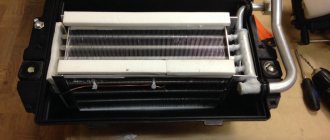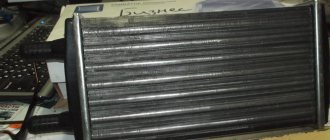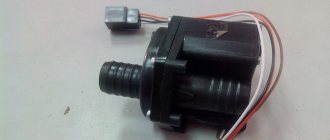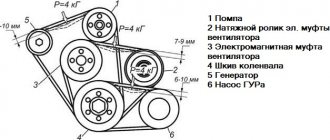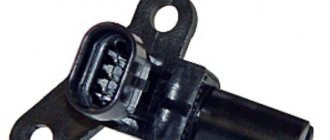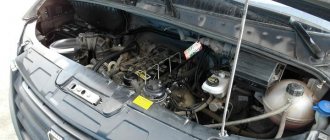Design of the cooling system for UMZ-4213 and UMZ-4216 engines on UAZ and GAZelle vehicles.
To increase energy performance, improve fuel economy, reduce toxicity and noise, models with an integrated microprocessor fuel injection and ignition control system were developed on the basis of the UMZ-421 carburetor engine: UMZ-4213 engine for UAZ cars and UMZ-4216 for GAZelle cars. The design of the cooling system on the UMZ-4213 and UMZ-4216 is somewhat different, since it has differences in the connection diagram of the expansion tanks and heating radiators.
General design of the cooling system of UMZ-4213 and UMZ-4216 engines on UAZ and GAZelle vehicles.
The cooling system is liquid, closed, with forced-type liquid circulation and an expansion tank, with liquid supply to the cylinder block. It includes a water pump, a thermostat, water jackets in the cylinder block and cylinder head, a heater, an expansion tank, a fan, connecting pipe sections, and also body heating batteries.
For proper operation of the UMZ-4213 and UMZ-4216 engines, the coolant temperature must be maintained within the range of plus 80-90 degrees. Short-term operation of the engine is allowed at a coolant temperature of 105 degrees. This mode may appear during the heat of the year when the car is driving with a full load on long climbs or in city driving conditions with frequent accelerations and stops.
Design of the UMZ-4213 engine cooling system on a UAZ vehicle.
Design of the UMZ-4216 engine cooling system on a GAZelle car.
Operation of the cooling system of UMZ-4213 and UMZ-4216 engines on UAZ and GAZelle vehicles.
Maintaining normal coolant temperature is done using a two-valve thermostat TS-107-01 with solid filling. When the engine warms up, when the coolant temperature is below 80 degrees, a small circle of coolant circulation operates. The upper valve of the thermostat is closed, the lower valve is open.
The coolant is pumped into the cooling jacket of the cylinder block by a water pump, from where, through holes in the upper plate of the block and the lower plane of the cylinder head, the liquid penetrates into the cooling jacket of the head, further into the thermostat housing and through the lower valve of the thermostat and the connecting pipe section - to the pump inlet for water. The heating device is disconnected from the main coolant flow.
For better operation of the interior heating system when circulating liquid in a small circle, and such a situation can be maintained for a very long time at low sub-zero ambient temperatures, there is a throttle hole with a diameter of 9 mm in the liquid outlet channel through the lower valve of the thermostat. Such throttling leads to an increase in the pressure drop at the inlet and outlet of the heating radiator and a more saturated circulation of liquid through this heating device.
Moreover, throttling the valve at the liquid outlet through the lower valve of the thermostat reduces the likelihood of emergency overheating of the motor in the absence of a thermostat, since the shunting effect of the small circle of liquid circulation is significantly weakened, due to which most of the liquid will flow through the cooling radiator.
Additionally, to maintain the normal operating temperature of the coolant during the cold season, UAZ vehicles may have blinds in front of the heater, thanks to which you can adjust the amount of air passing through the heater.
As soon as the temperature of the liquid increases to 80 degrees or more, the upper valve of the thermostat opens and the lower valve closes. The coolant circulates in a large circle through the heater.
To function well, the cooling system must be completely filled with liquid. When the engine warms up, the volume of liquid increases, the excess is pushed out due to increased pressure from the closed circulation volume into the expansion tank. When the temperature of the liquid decreases, for example, after stopping the engine, the liquid from the expansion tank, under the influence of the resulting vacuum, flows back into the closed volume.
On UAZ vehicles with a UMZ-4213 engine, the expansion tank is specifically connected to the atmosphere. The control of fluid exchange between the tank and the closed volume of the cooling system is changed by 2 valves, inlet and outlet, located in the plug of the heater.
Which radiator is better
When studying the design of the stove for passenger or cargo Gazelles, many owners wonder: which radiator copes better with its functions - aluminum or copper. Let's look at the main advantages of each of these options:
- Aluminum. It has an affordable cost, which can be 2 times lower compared to its copper counterpart. This is precisely the main reason why such products are distributed throughout the globe by manufacturers. Their main drawback is their lower thermal conductivity. The appearance of corroded areas can cause problems with the functioning of the entire heating and cooling system. They cannot be repaired - you have to throw them away and replace them with a new one.
- Copper. They have high thermal conductivity, and this directly affects the quality of interior heating. Copper is easy to solder, and therefore such radiators are repairable. The soldering is smoother and there are no oxides. The disadvantage is the higher selling price.
Experienced mechanics recommend installing a radiator made of copper after a major overhaul. Such a product will last longer, however, dirt particles can get into it, clogging the system. If there is no information about how dirty it is, then you can save money and install aluminum, which is simply washed during use.
Gazelle stove diagram
Additional heater
An additional heater is installed in the heating system of vehicles with two rows of seats, buses and emergency vehicles.
When the electric fan is turned on, the interior air circulates through the auxiliary heater radiator.
This ensures high intensity heating of the cabin (interior).
The auxiliary heater fan has a minimum and maximum rotation speed.
The auxiliary heater radiator is connected to the main heater radiator by hoses. They are laid on the floor and protected by a plastic casing.
The second radiator causes a decrease in the rate of fluid circulation in the heating system.
Therefore, an electric pump is installed together with the additional heater.
How the stove works in Gazelle Business
For correct diagnosis and repair, it is important to know the structure and operating principle of the heater, so that at the first sign of a breakdown, you can identify the problem or make repairs, preventing failure of the entire unit as a whole. Most breakdowns can be predicted by subtle signs and their progression can be prevented. To do this, you need to know and understand what any of the components is responsible for and what the meaning of its work is.
Car cooling system
In Gazelle Business, the stove is considered an important part of the engine cooling system. During engine operation, a lot of heat is generated that needs to be removed. Heat is released due to fuel combustion and from rubbing surfaces. If the heat is not removed, the motor will quickly heat up and break down. The cooling system has 2 circuits (small and large circle), they are divided by a thermostat. When the liquid is cool, it moves in a small circle, and when it warms up, it moves in a large circle. This makes it possible to quickly reach operating temperature and not get too hot. In the warm season, heat is released into the atmosphere, and when cool weather sets in, part of the heat is spent on heating the cabin.
Once we understand how the cooling system does not stop working, we can move on to heating the cabin. The heater circuit on a Gazelle car is similar to the heaters of other cars that have a liquid-cooled engine. Liquid can circulate through the heat exchanger of the heater no matter whether the thermostat is open or not. For better heat supply, the fluid for the stove comes from the hottest part of the engine (from the cylinder head). Thanks to this, on an engine that has not yet reached operating temperature, pleasant air still comes out of the deflectors. The heater has a valve in its design that either allows liquid to flow into the heating device or discharges it back. And the temperature of the environment leaving the deflectors depends on how much it is open. The valve position is adjusted from the heater control panel. The faucet is equipped with an electric drive that changes the position of the valve. It is also possible to change the blowing intensity and direction from the control panel. The intensity is controlled by a motor with an impeller, the rotation speed of which changes the intensity of the airflow.
Changing the position of the dampers changes the direction of the airflow (to the face, to the legs, to the chest, to the glass). The heated coolant from the engine penetrates through the line into the heater of the stove, causing it to heat up. At this time, air blown by a fan passes through it. Then it passes through air channels, the dampers of which are open. Then the hot air enters the car interior and warms it up. For repair work or diagnostics of breakdowns of this equipment, there is an electrical diagram on which all components of electrical devices are indicated. And in case of breakdowns or incorrect operation of devices, you need to read it in detail in order to understand where it is powered from and how the failed device changes.
When you know the working principle and device, it is much easier to navigate in case of breakdowns. After all, to successfully carry out a repair, it is necessary to understand the cause of the breakdown, otherwise the repair will not be completed successfully. For correct diagnosis, it is also necessary to understand the method of action of the entire mechanism in general. Nowadays, a driver does not have to know how to repair a car; there are service stations that deal with repairs of varying complexity. But it happens that a problem catches you on the road, and there is no opportunity to use the services of professionals. This is when knowledge of the automotive device and its mechanisms comes in handy. When you know how the Gazelle stove works, then if a breakdown occurs on another car, it will be easier to navigate when carrying out repairs or diagnostics, since in all cars they are almost equal, except for small invisible moments. And you can easily determine the breakdown.
What to assemble with your own hands
Many car enthusiasts like to build things with their own hands in the garage. How to assemble an additional stove for a Gazelle in this case from improvised means? First we need to find a housing that will house all the components and elements of the heater. Even a computer power supply case is suitable for these purposes. It needs to be completely disassembled, even removing the connectors and switch, since the case will be subject to severe overheating.
The second most important component will be the heating element, which will be located inside this housing. For this purpose, we will purchase a piece of nichrome wire or look for it in the garage. As a hint, this material serves as the basis for the manufacture of various springs and clamps. We must wind such a wire around any cone-shaped object. All that remains is to correctly calculate the load that will appear in addition to the standard electrical network.
As already mentioned, the radiator or stove is most often fixed under the right front passenger seat. To put the finished equipment into operation, you should display a button on the front panel - it will provide connection to the equipment. Let us immediately note that the driver needs to be prepared for the fact that it operates quite noisily. But it will cost less than buying a branded heater at a car dealership.
Disadvantage of the Gazelevsky pump
This device has one important drawback. Since its design is not fully thought out, after some time of operation the pump leaks. It leaks through the gasket. This problem can be solved, but it will require dismantling and disassembling the device. Treatment is to lubricate the gaskets with silicone or hot glue. And then the cover with gaskets is secured.
No such shortcomings were found in pumps from Bosh. This device is designed almost perfectly, and there are no gaskets. There is no leak.
Foreign pump
Imported devices have some advantages over domestic ones. One of them is weight. For example, the device from Bosch is lightweight, so it can be freely attached directly to the hoses. The difference in design is that the “Gazelle” pump is stuffing box. At high speeds, it creates increased pressure in the system and leaks. The imported device, on the contrary, has a sealless design, and the electric motor is in no way connected to the pump.
As for performance, it is preferable to purchase an imported additional pump for the Gazelle stove. Its description shows that it is superior in quality and power to its domestic counterpart. Its parameters are the same as in the domestic version. The device is powered by 12 V, and the pipe size is 18 mm.
As for the reviews about the operation of this additional pump, those who upgraded the heating in the Gazelle in this way were satisfied. In the harsh Russian winters, the cabin of the car became warm and cozy.
Direct installation
Before starting installation, you need to let the motor cool down. It's better to let it cool naturally. Then you need to drain the coolant into a previously prepared and clean container. It will still be useful, so it is better to make sure that it remains as clean as possible.
Next, take the new additional pump to the Gazelle stove and tighten the screws from the impeller side. The rubber gasket, which you will definitely find there, needs to be coated with a silicone-based sealant to prevent leakage. Then assemble this structure back, but throw away the screws, and instead install thin long bolts under ordinary nuts. This way you can make the connection as tight as possible.
Now let's move on to the next step. It consists of finding the installation location of the device. There are several options. This may be a place on the stud on which the washer reservoir is attached, on the stud near the battery.

